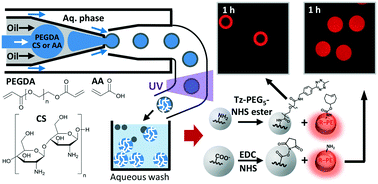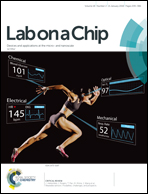High-throughput double emulsion-based microfluidic production of hydrogel microspheres with tunable chemical functionalities toward biomolecular conjugation†
Abstract
Chemically functional hydrogel microspheres hold significant potential in a range of applications including biosensing, drug delivery, and tissue engineering due to their high degree of flexibility in imparting a range of functions. In this work, we present a simple, efficient, and high-throughput capillary microfluidic approach for controlled fabrication of monodisperse and chemically functional hydrogel microspheres via formation of double emulsion drops with an ultra-thin oil shell as a sacrificial template. This method utilizes spontaneous dewetting of the oil phase upon polymerization and transfer into aqueous solution, resulting in poly(ethylene glycol) (PEG)-based microspheres containing primary amines (chitosan, CS) or carboxylates (acrylic acid, AA) for chemical functionality. Simple fluorescent labelling of the as-prepared microspheres shows the presence of abundant, uniformly distributed and readily tunable functional groups throughout the microspheres. Furthermore, we show the utility of chitosan's primary amine as an efficient conjugation handle at physiological pH due to its low pKa by direct comparison with other primary amines. We also report the utility of these microspheres in biomolecular conjugation using model fluorescent proteins, R-phycoerythrin (R-PE) and green fluorescent protein (GFPuv), via tetrazine–trans-cyclooctene (Tz–TCO) ligation for CS-PEG microspheres and carbodiimide chemistry for AA-PEG microspheres, respectively. The results show rapid coupling of R-PE with the microspheres' functional groups with minimal non-specific adsorption. In-depth protein conjugation kinetics studies with our microspheres highlight the differences in reaction and diffusion of R-PE with CS-PEG and AA-PEG microspheres. Finally, we demonstrate orthogonal one-pot protein conjugation of R-PE and GFPuv with CS-PEG and AA-PEG microspheres via simple size-based encoding. Combined, these results represent a significant advancement in the rapid and reliable fabrication of monodisperse and chemically functional hydrogel microspheres with tunable properties.



 Please wait while we load your content...
Please wait while we load your content...